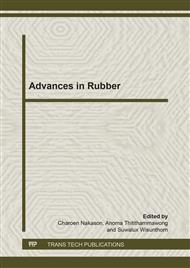p.309
p.314
p.318
p.322
p.326
p.330
p.334
p.338
p.345
Comparative Study on Natural and Synthetic Antioxidants on Thermo-Oxidative Aging of Natural and Synthetic Rubber Vulcanizates
Abstract:
Phenolic compound which was extracted from oil palm leaves is a renewable natural antioxidant (NA) and it was added into rubber compound in order to improve stability during thermo-oxidative ageing. The influence of NA in natural and synthetic rubber was investigated by comparing with TMQ, which is one of the most commonly used synthetic antioxidant in natural rubber (NR) product. Tensile properties, tear strength and crosslink density were investigated to interpret the experimental data related to the oxidation of natural (SMR CV60) and synthetic rubber (SBR). The results indicated that tensile, tear and crosslink density of NR were better than SBR for both compound with the presence of NA and TMQ. The presence of phenolic compound in NA could retard the oxidation activities of NR and SBR. On top of that, the structure of NR which induced strain crystallization had increased the tensile, tear and crosslink density of NR. Meanwhile, the bulky groups in SBR structure were interrupting the crystallization during stretching the rubber chains, resulting in lower mechanical properties. In general, NA was found to have better results on tensile, tear and crosslink density compared to TMQ in NR compound.
Info:
Periodical:
Pages:
326-329
Citation:
Online since:
November 2013
Keywords:
Price:
Сopyright:
© 2014 Trans Tech Publications Ltd. All Rights Reserved
Share:
Citation:


